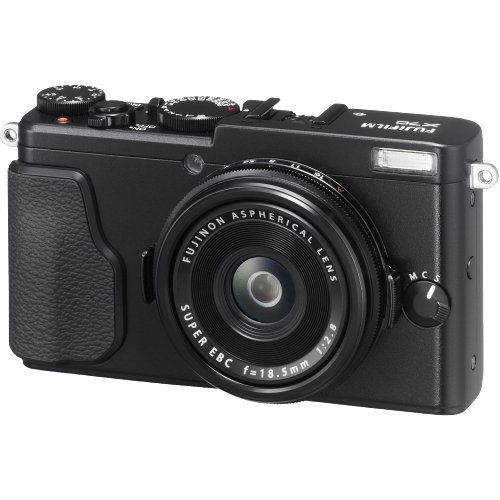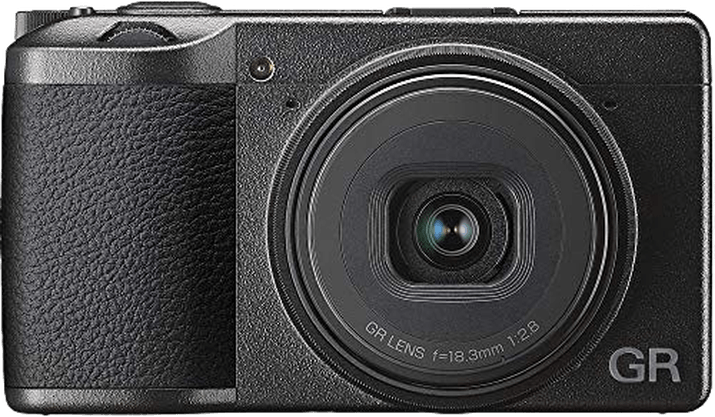Fujifilm X70 vs Ricoh GR III Comparison
Fujifilm X70

Ricoh GR III

The Ricoh GR III takes the lead with a score of 66/100, while the Fujifilm X70 trails behind with 53/100. Both cameras are compact in design, announced in 2016 and 2018 respectively. They share similarities in size, with the X70 measuring 113 x 64 x 44mm and the GR III at 109 x 62 x 33mm.
The Ricoh GR III excels with its lighter weight of 257g compared to the Fujifilm X70’s 340g. However, the X70 has a slightly lower launch price of $799, while the GR III was introduced at $899.
Despite the price difference, the Ricoh GR III’s higher score suggests it offers better overall performance and value. The Fujifilm X70 has its merits, but the GR III stands out as the superior choice in this comparison.
Fujifilm X70 vs Ricoh GR III Overview and Optics
The Ricoh GR III wins in the optics comparison against the Fujifilm X70, with a score of 68/100 compared to the Fujifilm X70’s 54/100. Both cameras share some specifications: they possess CMOS sensors, APS-C sensor sizes, and fixed lens mounts, meaning one cannot change the lenses.
The Ricoh GR III outperforms the Fujifilm X70 in several aspects. First, it has a higher megapixel count of 24, compared to the Fujifilm X70’s 16 megapixels, allowing for more detailed and higher resolution images. Second, it has a DXOMARK score of 76, while Fujifilm cameras do not receive DXOMARK scores. This score indicates better overall image quality in the Ricoh GR III. Lastly, the Ricoh GR III has image stabilisation, which the Fujifilm X70 lacks. This feature helps in capturing sharper images, especially in low-light conditions or when using slower shutter speeds.
On the other hand, the Fujifilm X70 has a faster shooting speed of 8, compared to the Ricoh GR III’s 4. This allows for better performance in capturing fast-moving subjects or action shots.
Taking these factors into account, the Ricoh GR III is the superior camera in terms of optics, offering higher resolution images, better overall image quality, and image stabilisation. The Fujifilm X70 has the advantage of a faster shooting speed, which may be preferable for photographers who prioritize action shots. However, the advantages offered by the Ricoh GR III make it a stronger choice for those seeking better optics in a compact camera.
Fujifilm X70 vs Ricoh GR III Video Performance
The Fujifilm X70 and Ricoh GR III both have a video score of 70/100, indicating that they share similar video capabilities. Both cameras offer Full HD video resolution with maximum dimensions of 1920 x 1080, and a maximum video frame rate of 60fps. Additionally, both have built-in time-lapse functionality.
The Fujifilm X70 and Ricoh GR III are equal in terms of their video specifications, making it difficult to determine a clear winner in this area. However, there are some aspects that each camera may excel in. For example, the Fujifilm X70 might have better video color rendition or autofocus performance, while the Ricoh GR III could offer better stabilization or low-light capabilities. These factors would need to be evaluated based on specific user needs and preferences.
On the other hand, it is also possible that the Ricoh GR III has some advantages over the Fujifilm X70 in terms of video performance. This could include features such as improved audio recording quality or more advanced video codecs for better compression and file sizes. Again, these factors would depend on individual user requirements and preferences.
In comparing the video capabilities of the Fujifilm X70 and Ricoh GR III, it is evident that they share many similarities, making it difficult to determine an outright winner. Both cameras offer Full HD video resolution, 60fps frame rates, and time-lapse functionality. The choice between the two ultimately depends on specific user needs and preferences, as well as any potential advantages one model may have over the other in terms of video performance.
Fujifilm X70 vs Ricoh GR III Features and Benefits
The Ricoh GR III outperforms the Fujifilm X70 with a feature score of 70/100 compared to the X70’s 57/100. Both cameras share some common specifications, such as a 3-inch screen size, touchscreen functionality, and WIFI connectivity. Neither camera has GPS capabilities.
The Ricoh GR III surpasses the Fujifilm X70 in various aspects. Firstly, the GR III has Bluetooth connectivity, which the X70 lacks. This feature allows for easy pairing with compatible devices and enhances remote control capabilities, providing a more convenient user experience. Additionally, the screen resolution of the GR III is slightly higher at 1,037,000 dots compared to the X70’s 1,040,000 dots. This difference results in a marginally sharper and clearer display on the GR III.
On the other hand, the Fujifilm X70 possesses a flip screen, which is absent in the Ricoh GR III. A flip screen enables users to shoot from various angles and is especially useful for capturing selfies or shooting videos. This feature is a notable advantage of the X70 over the GR III.
Taking into account these differences, the Ricoh GR III’s higher feature score reflects its superior Bluetooth connectivity and marginally better screen resolution. However, the Fujifilm X70’s flip screen offers a unique advantage for users seeking versatility in shooting angles. Ultimately, the choice between these two cameras will depend on the individual’s specific needs and preferences, with the Ricoh GR III offering better connectivity and the Fujifilm X70 providing more flexibility in composition.
Fujifilm X70 vs Ricoh GR III Storage and Battery
The Ricoh GR III outperforms the Fujifilm X70 in storage and battery, scoring 27 points compared to the X70’s 21 points. Both cameras share similarities in storage, as they each have one memory card slot and accept SD, SDHC, and SDXC cards. However, the GR III sets itself apart by being UHS-I compatible and offering internal storage.
In terms of battery, the Fujifilm X70 has an advantage with 330 shots per charge, using an NP-95 battery. The Ricoh GR III falls short, providing only 200 shots with its DB-110 battery. Despite this, the GR III compensates with the convenience of USB charging, a feature absent in the X70.
Considering these factors, the Ricoh GR III proves to be the superior option in storage and battery due to its UHS-I compatibility, internal storage, and USB charging capability. However, the Fujifilm X70 still holds its ground with longer battery life per charge.
Fujifilm X70 vs Ricoh GR III – Our Verdict
Are you still undecided about which camera is right for you? Have a look at these popular comparisons that feature the Fujifilm X70 or the Ricoh GR III:

